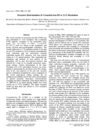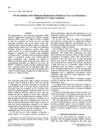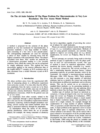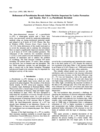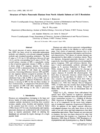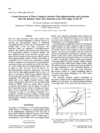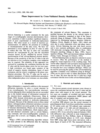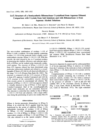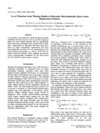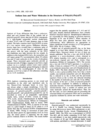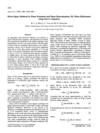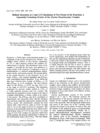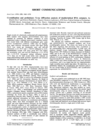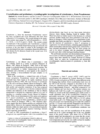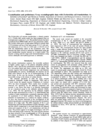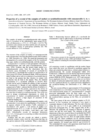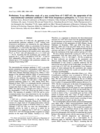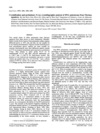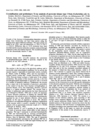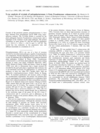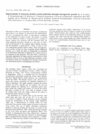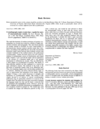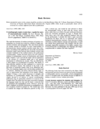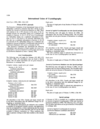issue contents
November 1995 issue

Cover illustration: Active site of purine nucleoside phosphorylase with the electrostatic potential surface and dipole of guanine. Rendered with Ribbons++ and SPARTAN.
research papers
Laue diffraction data have been collected from canine parvovirus (CPV) and human rhinovirus 14 (HRVl4). In optimal conditions one or two images of HRVl4 were sufficient to determine the presence of a point mutation from a leucine to a valine, and to calculate interpretable electron-density maps of virus-antiviral compound complexes at 3.5 Å resolution.
The structure determination of CVB3 using molecular replacement involved characterizing pseudo R32 symmetry and allowed for 120-fold non-crystallographic averaging which resulted in a high-quality electron-density map.
The applicability of the molecular-replacement method to structure solution at very low resolution is shown, both with atomic and non-atomic (envelope) models. The specific nature of the signal at this resolution required the development of a new protocol for molecular replacement.
The phase problem is solved ab initio at very low resolution for macromolecular through the random generation of a very large amount of few atoms models, the selection of the best ones with an amplitude correlation checking, and the grouping the best models in `clusters'. Applications are described.
Improved re-refined structure of α1-purothionin is described. The crystal structure contains the newly found solute molecules (phosphate, acetate and glycerol). These are hyphothesized to be important in lattice assembly and toxicity.
PDB reference: 2plh
The crystal structure of β-purnthionin at 1.7 Å is presented. The crystal structure contains the same solute molecules as found before in α1-purothionin (phosphate, acetate and glycerol). These are hypothesized to be important in lattice assembly and toxicity.
PDB reference: 1bhp
The structure of salmon pancreatic elastase at 1.61 Å is the first molecular structure of an elastase from a cold-adapted species.
PDB reference: 1elt
Incomplete factorial analysis was used to design oligonucleotide sequences for cocrystallization with EcoRI endonuclease. Presence of DNA in the co-crystals was confirmed by a dye test.
The first three-dimensional structure of class II major histocompatibility complex glycoprotein was determined by non-crystallographic averaging of dimers of HLA-DRi heterodimers from three crystal forms.
Crystal structures of three complexes between the rainbow trout lysozyme and oligomers of N-acetylglucosamine were determined. The paper describes the binding of these oligosaccharides to the A, B, C and D sites of the active-site cleft of thc lysozyme.
The P atoms in oligonucleotide crystals can be located by using anomalous-scattering differences, |δF|, in the direct-methods program MULTAN. Success is not dependent on having high- resolution data, but the errors in the |δF|'s must be small.
Cross-validation has been used to optimize the performance of density-modification methods. A high correlation was found between the cross-validated R value and the model phase errors for two test cases, indicating that this method is likely to be useful when initial phase estimates are unavailable.
The 1.6 Å structure of a semisynthetic RNase from 43% aqueous ethanol closely resembles the 1.8 Å structure obtained from crystals grown in concentrated salt solution, although a major difference is the positioning of active-site residue His119.
PDB reference: 1ssc
The structure of the title protein was determined at 1.9 Å resolution and refined to an R value of 0.19. Two independent molecules are related with a local twofold axis to form a dimer structure.
PDB reference: 1wgt
The triples invariant translation function is used to quickly determine plausible relative heavy-atom sites for SIR and SAS data. These candidate peaks may be recycled through the minimal function to obtain an origin consistent set for multisite derivatives.
X-ray fiber diffraction analysis reveals that the poly(dA).poly(dT) double helix is stabilized by a spine of continuously hydrogen-bonded water molecules in the minor groove. Phosphate groups of adjacent DNA helices are linked via bridges formed by solution ions and water molecules.
PDB reference: 1ply
The H-protein is the mechanistic heart of the multienzymatic complex of the glycine decarboxylase. Its lipoate cofactor is linked to a lysine located in a hairpin configuration and moves freely. Following binding of methylamine residue, it is locked in a cleft at the surface of the protein.
The structure of a new azurin from Alcaligenes xylosoxidans has been solved by the molecular-replacement method. A detailed comparison is made with the high-resolution structures of azurins from Akaligenes denitrificans and Pseudomonas aeruginosa.
PDB reference: 1arn
short communications
The crystallization of chemically synthesized RNA oligonucleotides by the sparse-matrix technique is reported. Two crystal forms of the RNA octamer r(CCCCGGGG) have been obtained.
The dihaem cytochrome c4 from Pseudomonas stutzeri has been crystallized in the space group P21 with unit-cell dimensions a = 49.49, b = 58.58, c = 63.51 Å and β = 96.96° and two molecules per asymmetric unit. The positions of the four independent Fe atoms were determined from the anomalous Patterson map.
The Escherichia coli transketolase enzyme has been crystallized in a form suitable for X-ray crystallographic analysis. The structure has been solved by molecular replacement allowing the high-resolution (1.9 Å) structural determination of this important carbon~arbon bond-forming enzyme.
The complex of methyl α-D-arabinofuranoside with concanavalin A crystallizes in space group P21221 with cell dimensions a = 97.5, b = 87.0 and c = 61.5 Å. The crystals diffract to 2.0 Å resolution.
Cell dimensions and preliminary studies on two new crystal forms, a monoclinic and a tetragonal form, are reported for staphylococcal enterotoxin C2.
N-Acetylgalactosamine-4-sulfatase, a lysosomal enzyme involved in the degradation of glycosaminoglycans (mucopolysaccharides), has been crystallized.
A new crystal form of C-1027-AG, the apoprotein of the macromolecular antitumor antibiotic C- 1027 isolated from Streptomyces globisporus was obtained using lithium sulfate as a precipitant.
The crystal forms of DNA polymerase from Thermus aquaticus have been grown. Trigonal crystals are suitable for structure determination.
Pyruvate kinase from E. coli has been crystallized providing the basis for understanding the molecular mechanism for the allosteric transition.
Methyltetrahydrofolate:corrinoid/iron sulfur protein methyltransferase from Clostridiuin therinoaceticum has been crystallized and characterized by X-ray diffraction.
The enzyme lactoperoxidase, a glycoprotein which exhibits bactericidal and bacteriostalic effects has been isolated from buffalo milk. It has been crystallized with 10%(v/v) ethanol. The green-coloured plate-like crystals are orthorhombic in space group P212121 with unit-cell dimensions a = 116.9, b = 103.2, c = 62.3 Å.
Crystallization report of a polygalacturonase from Pseudomonas solanacearum, a secreted plant-virulence determinant.
The mosaicity of microgravity-grown lysozyme protein crystals is shown to have improved by a factor of three to four over earth-grown controls yielding essentially perfect crystal diffraction gratings. The peak to background of the diffraction intensities is thereby enhanced by a similar factor, illustrating the link between the geometric perfection and the resolution. The results set a benchmark for all future microgravity and earth-based procedures.
book reviews
Free 

books received
Free 

international union of crystallography
Free 

Free 



 journal menu
journal menu










